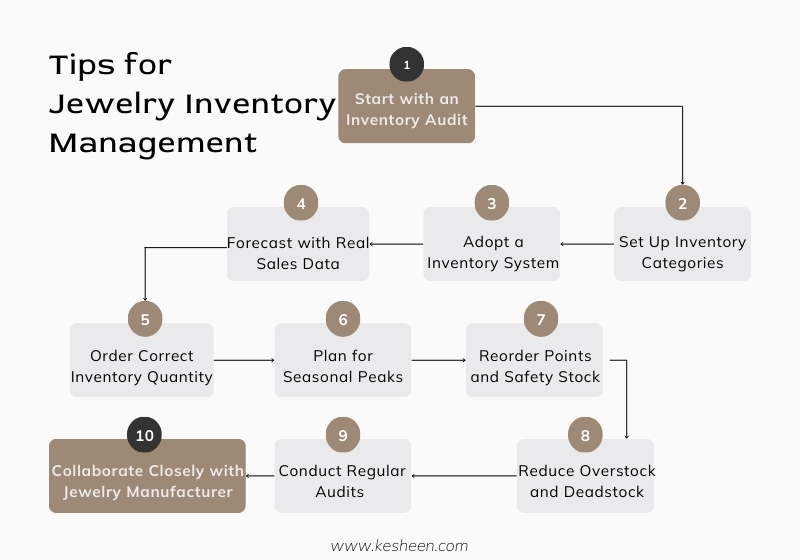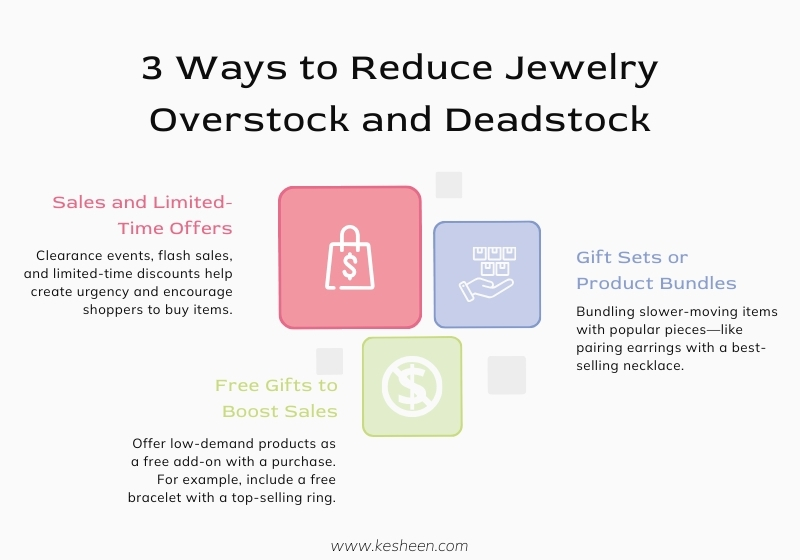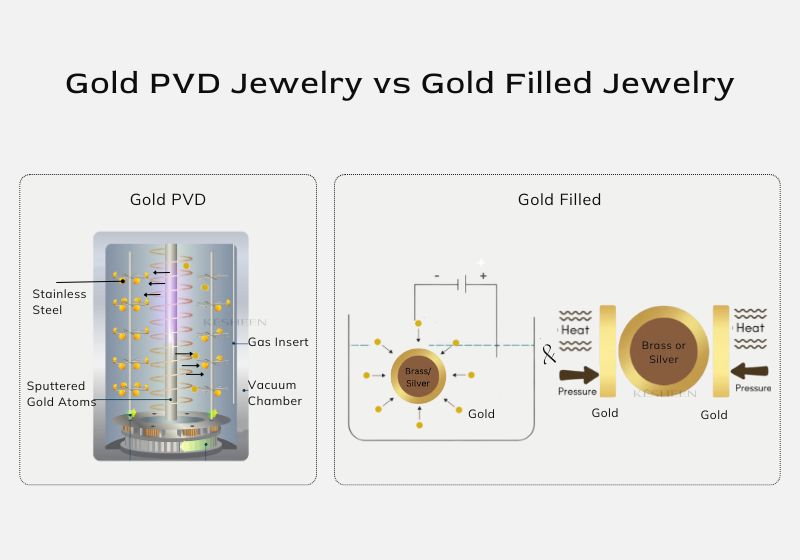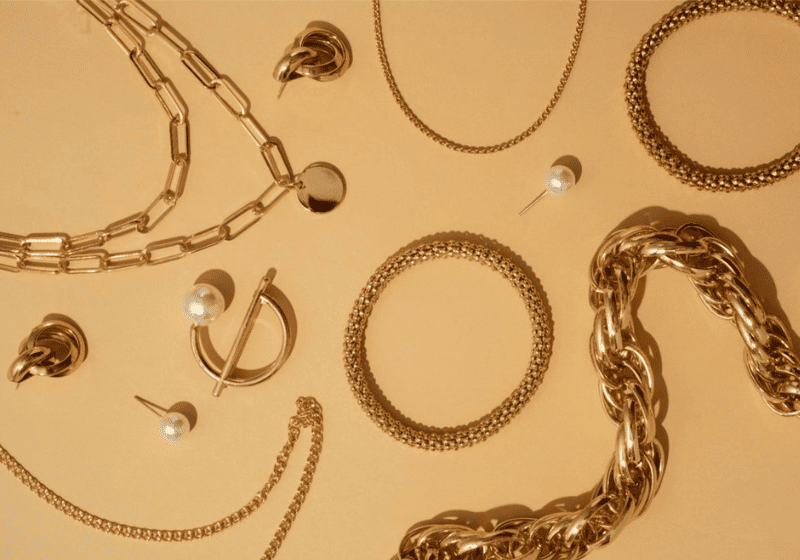Effective jewelry inventory management is the backbone of a thriving jewelry business. Poorly managed stock ties up cash, frustrates customers, and leaves you unprepared for holiday sales jewelry spikes. This guide shares practical tips to streamline your inventory for jewelry business, prepare for holiday jewelry inventory, and grow with confidence.

Start with an Inventory Audit
A solid audit is the first step to mastering your jewelry inventory system. It reveals what’s working and what’s not.
- Perform a Full Physical Count
Count every piece, from raw materials to finished jewelry. Use a checklist, involve your team, and double-check for accuracy. This snapshot of your jewelry inventory guides smarter decisions.
- Identify Obsolete or Unsellable Stock
Spot items gathering dust—outdated designs or damaged pieces. Flag them for promotions or recycling to clear space and recover capital in your inventory for jewelry business.
- Separate Custom, Standard, and Seasonal Inventory
Divide inventory into custom orders, everyday stock, and seasonal pieces (like holiday sales jewelry collections). This organization simplifies tracking and boosts seasonal inventory management.
Set Up Inventory Categories Effectively
Clear categories make jewelry inventory management intuitive and efficient for your team. They also contribute to stronger jewelry brand positioning by ensuring consistency across your product presentation.
- Organize by Materials (e.g., Stainless Steel, Silver, Gold)
Segment your inventory by core materials like stainless steel jewelry, silver, or PVD gold plated jewelry. It helps with sourcing and reordering.
- Categorize by Product Type (Ring, Necklace, Set, etc.)
Group by type—rings, necklaces, sets. No matter how you organize your jewelry store, keep it consistent, so you can do quick access and sales analysis later.
- Organize by Price
Arrange by price tiers (budget, mid-range, premium) to match customer needs and streamline jewelry stock planning for different markets.
- Barcode Systems for Quick SKU Tracking
Use barcodes to assign unique SKUs, speeding up updates and reducing errors in your jewelry inventory system, especially during busy holiday sales jewelry periods.

Adopt a Jewelry-Specific Inventory Management System
Invest in jewelry inventory management software like JewelMate or Shopify POS. These tools track materials, SKUs, and sales, syncing with platforms to sell jewelry online or in store. With clear data and automatic updates, you can confidently manage stock and make smarter, faster inventory decisions as your business grows.
Forecast with Real Sales Data
Accurate forecasting prevents stock issues and optimizes jewelry stock planning.
- Use Your Sales Reports to Predict Future Demand
Analyze what’s sold over the last 3, 6, or 12 months. Review sales data to spot top sellers and guide your upcoming purchases. Restock what’s hot to meet customer demand without overbuying.
- Incorporate Seasonal and Trend-Based Forecasting
Plan for seasonal collections and upcoming fashion trends using social media insights and industry reports. Stay ahead of what customers want.
- Use Customer Pre-Orders to Estimate Interest
Collect pre-orders to test new styles or seasonal launches before investing heavily. This informs production, especially for custom orders, minimizing excess jewelry inventory.
The Risks of Imbalanced Inventory
Managing inventory is a balancing act. Having too much inventory ties up your cash flow, increases storage costs, and risks unsold stock becoming outdated or obsolete. On the other hand, too little inventory can lead to stockouts, disappointed customers, and lost sales opportunities. Both extremes hurt your business profitability and growth potential.
Maintaining the right inventory levels ensures you meet demand without overcommitting resources—key to a healthy, scalable jewelry business.
Order the Correct Quantity of Inventory
Avoid costly overstock or stockouts by monitoring product performance closely. Review your sales data regularly to see which items sell fast and which ones don’t. Adjust your purchase quantities accordingly.
A strong partnership with jewelry suppliers also gives you flexibility. When your custom jewelry manufacturer knows you’re reliable, pay promptly, and communicate clearly, they can better offer tailored order quantity suggestions based on your sales and production cycles.
Plan for Seasonal Peaks
Planning for peak seasons starts months in advance. Review past holiday trends and increase orders for high-demand products early. Scale back purchases during slower months to prevent overstock.
- Pre-stock gift boxes and packaging to avoid last-minute delays.
- Launch early promotions with jewelry marketing ideas like holiday-themed bundles or limited editions.
- Drive traffic through targeted social media content and paid campaigns to maximize seasonal sales.
Use Reorder Points and Safety Stock for Stability
Set clear reorder points based on your average sales velocity so you always restock before running out. Add a layer of safety stock to protect against shipping delays or surprise spikes in demand. This extra buffer ensures your jewelry inventory control stays strong—even when the unexpected happens—keeping your shelves stocked and customers satisfied without over-ordering.

3 Effective Ways to Reduce Overstock and Deadstock
In retail, not every item sells at the same pace. While some jewelry flies off the shelves, others tend to linger. To avoid tying up cash in slow-moving inventory, try these practical solutions.
- Run Sales and Limited-Time Offers
Clearance events, flash sales, and limited-time discounts can help create urgency and encourage shoppers to buy items they may have previously overlooked.
- Create Gift Sets or Product Bundles
Bundling slower-moving items with popular pieces—like pairing earrings with a best-selling necklace—adds value and makes the purchase more appealing.
- Use Free Gifts to Boost Sales
Offer low-demand products as a free add-on with a purchase. For example, include a free bracelet with a top-selling ring to drive conversions while clearing extra stock.

Conduct Regular Audits and Cycle Counts
Waiting until year-end for a full inventory count often leads to errors and surprises. Instead, run monthly cycle counts by category or section. This ongoing process helps you catch discrepancies early, correct miscounts, and maintain accurate records. With frequent checks, your inventory for jewelry business stays in sync with reality—leading to better forecasting, smarter reordering, and smoother operations all year long.
Collaborate Closely With Your Jewelry Manufacturer
Building strong, trusting relationships with your suppliers allows for greater flexibility and strategic support when you need them most. At Kesheen, our integrated project management system ensures clear timelines and a smoother path from concept to launch—helping your jewelry business stay agile and ahead.
Simplify Your Jewelry Inventory
With the right systems and partners in place, inventory becomes a tool for growth—not a source of stress. Start these steps today to boost profits and build a scalable inventory for jewelry business that grows with your brand’s vision.
FAQs
Use barcode-labeled SKUs, categorize items by type, material, and price tier, and update inventory counts regularly. For efficiency, use jewelry inventory management software to track stock levels, sales, and reorder points in real time.
Use spreadsheets with SKU codes, barcode labels, and physical cycle counts to track stock. While it’s manual, this method can work for small-scale operations before moving to software.



